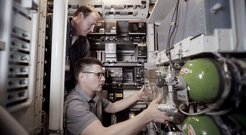Climate research above the clouds
(Text modified according to template of BMBF)
The climate is changing - but how can we measure the change? How can we make reliable predictions about how the climate will develop in the future? To this end, the European research infrastructure IAGOS (In-service Aircraft for a Global Observing System) has been established in recent years. Since 2012, the German Federal Ministry of Education and Research (BMBF) has financed the development of the German part - IAGOS-D - with around 19 million euros. Seven research institutions participated in the IAGOS-D collaborative project, which has now ended: Forschungszentrum Jülich, Karlsruhe Institute of Technology (KIT), Max Planck Institute for Biogeochemistry (MPI-BGC), Max Planck Institute for Chemistry, Leibniz Institute for Tropospheric Research e.V. (TROPOS), Heidelberg University and the German Aerospace Center (DLR).
The goal of IAGOS: to develop a special uniform measuring technique for airliners, to equip them with measuring instruments and thus to regularly obtain extensive data from the atmosphere from the ground up to a maximum altitude of 13 kilometers by regularly conducted flights of international airlines. The development of the measurement technology has now been completed and is already being used in eight aircraft. In addition, Lufthansa will convert a new long-haul Airbus next year so that it can integrate the IAGOS-CARIBIC measurement laboratory there and collect further data for climate research worldwide. In the future, the IAGOS-AISBL operating association will take over the further coordination of the IAGOS research infrastructure.

Under the leadership of Dr. Christoph Gerbig at the MPI-BGC, several IAGOS projects were carried out since 2005, to help realize the IAGOS infrastructure. In particular, the system for the simultaneous measurement of the greenhouse gases CO2, CH4, CO and H2O was developed for a continuous application on airliners, in close cooperation with the partner enviscope GmbH.
Continuous measurements of the atmosphere - in near real time
The IAGOS measurement technology has been developed by researchers in such a way that the collected data can be retrieved as quickly as possible. For this purpose, the system is permanently installed directly below the aircraft cockpit. A short connection leads from there to two measuring probes installed in the aircraft fuselage. After each flight, the collected measurement data are automatically transmitted to the central IAGOS database and to the Copernicus atmospheric monitoring service of the European Center for Medium-Range Weather Forecasts. The data collected there are freely accessible. In particular, the data collection helps researchers gain new insights into the evolution of climate and the changing composition of the atmosphere, detect long-term changes, and refine climate models. In addition, the data are used worldwide by the various weather services for weather forecasts.












